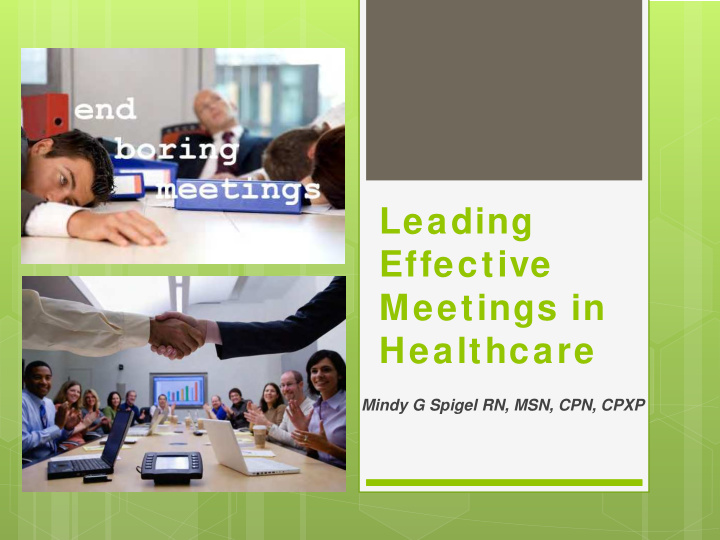



Leading Effective Meetings in Healthcare Mindy G Spigel RN, MSN, CPN, CPXP
A camel is a horse designed by a committee
Objectives Assess the need for a meeting, appreciating its cost to the organization. Plan a well organized meeting, generating an effective agenda. Conduct a productive and efficient meeting, facilitating group process and problem solving. Evaluate the effectiveness of the meeting in terms of accomplishing objectives AND facilitating members feelings of involvement.
How much do meetings cost? Average 2 4 6 8 10 12 hourly wage $5 10 20 30 40 50 60 $10 20 40 60 80 100 120 $15 30 60 90 120 150 180 $20 40 80 120 160 200 240 $25 50 100 150 200 250 300 $30 60 120 180 240 300 360
What could go w rong? No agenda/goals Disorganized No pre meeting orientation Ineffective leader Late start Irrelevant information Poor/inadequate Time wasted preparation Interruptions Getting off the subject Rambling digressions Too long No published results Inconclusive Ineffective decision-making
5 R’s of a Good Meeting Right Meeting Right Route Right Time Right People Right Preparation (dose)
5 R’s of a Good Meeting Right Meeting Right Route Right Time Right People Right Preparation (dose)
Sometimes…. medication is a lot to swallow.
5 R’s of a Good Meeting Right Meeting Right Route Right Time Right People Right Preparation (dose)
The length of meeting increases in direct proportion to the square of the number of people present and awake Anonymous
5 R’s of a Good Meeting Right Meeting Right Route Right Time Right People Right Preparation (dose)
5 R’s of a Good Meeting Right Meeting Right Route Right Time Right People Right Preparation (dose)
Creating the agenda Organize your items Start with those that unite, uplift Middle 1/3, most people present and alert Expectations clear Notify people if on they are on the agenda
Parts of Agenda Items Topic Action Orienting Information Time allotted Person Responsible
Conducting the Meeting Start on time Provide direction Create a relaxed atmosphere Attendance Gatekeeper Watch group dynamics Ground rules
Ruthless Gatekeeper Talk Show Host Keep meeting moving Do not let group get bogged down on one issue Given the late time.. Let’s hear 2 more comments That point leads to the next..
Group Dynamics Encourage enabling behaviors Ignore or confront dysfunctional behaviors Keep it positive, productive, on track Redirect monopolizers Encourage the quiet members
Decision-Making Clear definition of problem Exercise restraint Brainstorm (Generate lots of ideas) Disagreement is okay Maintain positive tone Action plan
Problem Solving Diagnose the problem Enthusiastic First 5 -10 solutions (no censoring) Analysis Select choice (multivote) Get consensus, put into the minutes
Set the standard that challenges are w elcomed in your committee, but come prepared w ith solutions and w e w ill discuss. Get rid of dumping and chronic complaining …OWNERSHIP
Motivating the Committee to Get Work Done Your committee supports the idea of creating a brand new health education curriculum for the elementary schools. The school board approves the decision, but says it will be your job to implement the change including developing the educational materials, product, educating the school nurses about the program, introducing the program to the principals and the schools and developing the necessary policy and procedures. When you ask your committee of 15 where to go from here, the room is silent as everyone is looking back at you.
As the team presents the new curriculum to the nurses, Wanda Itwontwork immediately took her stance and said “no way”!!! “our school is different;” “we won’t do it, it won’t work” Several other nurses reported knowing other school districts who have done it successfully. Wanda and her friends snickered among themselves, brushing off the speaker. Everyone else became quiet.
Attendance Plenty of notice Fun notification/enticing Food, Door prizes Timing Comments are taken seriously; attendance makes a difference Decisions are not already made Involve everyone; involved people more likely to attend What percentage is one way communication? Results?
Participation Enthusiasm Brainstorming Open ended questions Ask for and encourage different opinions Thank people for their input
Meetings are running too long…… Too much on agenda? Off topic? Repetition? Rambling digressions? Difficulty with decisionmaking? Start on time, finish on time Time keeper Rules decided by all and posted each time
Negativity Change is hard Blockers and naysayers: who has the power? We tried that before Bring a solution Time limit Ground rules
Volunteers Typically 80% of the work is done by 20% of the people What keeps people from volunteering? Small bites Trying to accomplish too much? Recognize and make them feel needed Buddy assignments
Get and Keep the Excitement Going Start with the small stuff One or two goals at a time Team input Results and celebrations
Why Minutes? Captures essential information of a meeting Decisions made: Who, what, when, where, how, why Action items: get work done Assignments Keeps attendees on track Useful information for people not at the meeting
What should be included? Type of meeting Date, time, location Attendance Motions and decisions Business discussed Assignments Date for next meeting Adjournment
Too much or too little? Typically, less is more Topic, decision, action plan, person responsible Focus on the decisions and action items NOT the verbatim discussion
How to take minutes: Before the meeting Template Agenda: use it to formulate an outline Sign in sheet Decide on tool to use (tape, computer, pen and paper)
How to take minutes: During the meeting Pass around the attendance sheet Note the time meeting started Don’t write down every word, just the main idea Record motions and decisions Record any items tabled or referred to the next meeting Assignments/Action items Adjournment time
How to take minutes: After the meeting Type up the minutes as soon as possible Be objective Ask someone to review the minutes Proofread before submitting Save a copy for the future
Summarize: Wrap it up! What’s decided Responsibilities Deadlines
Follow Up/Evaluation Preparation Attendance Worth Participation Group Dynamics Assignment sheet Next agenda
Questions? Thank you!!
Recommend
More recommend